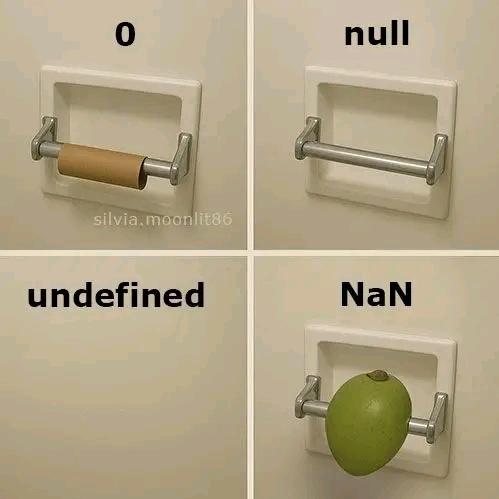This comprehensive guide will break each one down with clear examples, practical tips, common pitfalls, and advanced behaviors you should be aware of as a developer.

In JavaScript, values like null, NaN, undefined, and 0 often pop up when dealing with logic, data structures, and user input. They seem similar — like different ways to represent "nothing" or "empty" — but they behave differently and serve very distinct purposes.
undefined: The Value of “Not Yet Defined”undefined?undefined is a primitive value that indicates a variable has been declared but not yet assigned a value.
Accessing an uninitialized variable:
Accessing a non-existent object property:
Function with no return statement:
Missing function parameters:
| Feature | Value |
|---|---|
| Type | 'undefined' |
| Falsy? | ✅ Yes |
| Equality | undefined == null is true |
| Best Check | typeof x === 'undefined' or x === undefined |
Use undefined implicitly for variables or properties that haven’t been assigned or are optional.
null: The Intentional “Nothing”null?null is a primitive value that represents the intentional absence of any object value. It must be assigned explicitly.
nullTo initialize a variable that should later hold an object or value.
To explicitly clear a variable.
To communicate “no value” or “empty on purpose.”
| Feature | Value |
|---|---|
| Type | 'object' (quirk) |
| Falsy? | ✅ Yes |
| Equality | null == undefined is true, but null === undefined is false |
| Best Check | value === null |
🧠 Note:
typeof null === 'object'is a long-standing bug in JavaScript.
Use null when you want to reset a value or signal the absence of a value explicitly.
NaN: Not-a-NumberNaN?NaN is a numeric value that indicates the result of a mathematical operation that doesn’t yield a real number.
Invalid arithmetic:
Failing type coercion:
NaN is Tricky| Feature | Value |
|---|---|
| Type | 'number' |
| Falsy? | ✅ Yes |
| Unique | Only value in JS that’s not equal to itself |
| Best Check | Number.isNaN(value) (reliable) |
Handle NaN when dealing with:
User inputs
Complex calculations
API responses that expect numbers
0: The Valid, Yet Falsy Number0?0 is a numeric value that represents the number zero. While it’s a valid number, it evaluates to false in boolean contexts.
As a result of subtraction, division, etc.
As a user input for “none” or “zero” quantity
Default counter or accumulator values
| Feature | Value |
|---|---|
| Type | 'number' |
| Falsy? | ✅ Yes |
| Equality | 0 == false is true, 0 === false is false |
| Best Check | value === 0 |
🚨 Pitfall: Don't confuse
0withnullorundefined. It’s a valid value.
Use 0 in:
Mathematical calculations
Loop counters
Representing "no quantity" or "zero balance"
| Value | Type | Meaning | Falsy? | Common Use Case |
|---|---|---|---|---|
undefined | 'undefined' | Variable not yet assigned | ✅ Yes | Uninitialized or missing value |
null | 'object' | Empty on purpose | ✅ Yes | Intentional no-value assignment |
NaN | 'number' | Invalid numeric result | ✅ Yes | Math or parsing errors |
0 | 'number' | Valid number, falsy in logic | ✅ Yes | Numeric zero, counters, balances |
| Expression | Result | Why? |
|---|---|---|
undefined == null | true | Loose equality treats both as empty |
undefined === null | false | Strict equality requires same type |
NaN == NaN | false | Special case in JS |
Number.isNaN(NaN) | true | Proper way to check for NaN |
0 == false | true | Type coercion with loose equality |
0 === false | false | Strict equality: different types |
null for:Resetting values
Emptying an object reference
Signaling “empty on purpose”
undefined for:Optional function arguments
Uninitialized variables
Missing properties
NaN with caution:Always validate user inputs
Use Number.isNaN() instead of isNaN() to avoid false positives
0 carefully:Understand it’s falsy in conditionals
Don’t mistake 0 for missing data
Although null, undefined, NaN, and 0 all deal with “emptiness” in some form, each plays a specific role in JavaScript’s ecosystem. Understanding their differences helps avoid common bugs, improves your logic checks, and makes your code more robust.
As a developer, being precise about your intention — whether a value is missing, invalid, or deliberately empty — is crucial. Choose the right value to represent the right scenario.
Your email address will not be published. Required fields are marked *